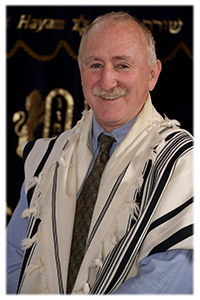Shabbat Bemidbar usually falls near Shavuot: the day designated as the anniversary of the revelation of Torah at Mt. Sinai. According to a midrash Shavuot is like the wedding anniversary of God and the Jewish people. In Exodus as the revelation unfolds, the position of the Israelites is described with a phrase: בְּתַחְתִּ֥ית הָהָֽר/betakhtit ha-har, which figuratively means “at the base of the mountain” but literally means “under the mountain”. To explain this the rabbis said that Mount Sinai was held over the Israelites like a wedding huppah. Hence, revelation was like a wedding, a binding, covenantal moment between God and Israel.
The motif of marriage is also central to the story of Ruth, a biblical book that we read during Shavuot. Ruth, a Moabite woman, enters into the covenant of the Jewish people through her marriage to Chilion, the son of Elimelach. Her “conversion” is poetically sealed after Chilion’s death when, despite her mother-in-law Naomi’s discouragement, Ruth proclaims to Naomi, “For wherever you lodge, I will lodge; your people shall be my people, and your God my God”. (Ruth 1:16-17) Finally, the Book of Ruth concludes with Ruth marrying her redeemer Boaz.
This week’s haftarah also contains a beautiful and poetic marriage image. The Prophet Hosea, speaking for God, proclaims, “In that day, I will make a covenant for them … And I will marry you forever: I will marry you with righteousness and justice, and with goodness and mercy, And I will marry you faithfulness; then you shall be devoted to the Lord”. (Hosea 2:20-21). These are the same words that accompany the ritual of putting on tefillin—they are recited while entwining the strap of the tefillin around your hand like a wedding ring.
It is tempting to use these connections as paean to marriage. However, I would like to suggest that the essence of these texts speak not to the institution of marriage, but to what a marriage implies: binding commitment and courage. Sustaining commitment to a relationship is often challenging. It requires a blend of courage, tenacity, and risk taking. The Torah portion picks up these themes, opening with a list of the names of leaders who will assist Moshe with an important task. One of the men named is Nachson. According to a midrash (Mechilta de-Rabbi Yishmael 14:22), Nachson was the first person to risk entering the Reed Sea as the Israelites were fleeing Egypt. He entered the water and continued to walk until he was nearly submerged until the waters finally parted. Nachson later had four sons, including Elimelach, husband of Naomi, as well as Shalmon, father of Boaz. Hence, Nachson was father and uncle to two important figures in the Book of Ruth. He is again mentioned at the end of the Book of Ruth where the connection between Ruth and King David is laid out.
The lesson is clear: relationships, whether between lovers, family members or community members, require commitment and courage.








